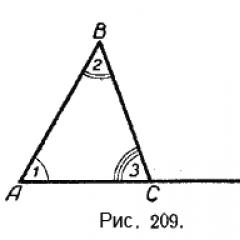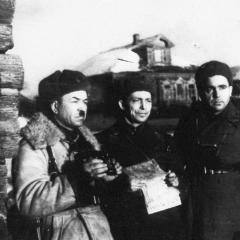Glycerin reacts with copper. A qualitative reaction to glycerol is specific, helping to detect it. Chemical properties of glycerin
Place 2 drops of copper sulphate solution, 2 drops of sodium hydroxide solution into a test tube and mix - a blue gelatinous precipitate of copper (II) hydroxide is formed. Add 1 drop of glycerin to the test tube and shake the contents. The precipitate dissolves and a dark blue color appears due to the formation of copper glycerate.
Process chemistry:
Copper glycerate
Glycerin is a trihydric alcohol. Its acidity is greater than that of monohydric alcohols: an increase in the number of hydroxyl groups enhances the acidic character.
Glycerin readily forms glycerates with heavy metal hydroxides. However, its ability to form metal derivatives (glycerates) with polyvalent metals is explained not so much by its increased acidity, but by the fact that intra-complex compounds with special stability are formed in this case. Compounds of this kind are called chelated (from the Greek "hela" - claw).
The reaction with copper hydroxide is a qualitative reaction for polyhydric alcohols and makes it possible to distinguish them from monohydric ones.
Oxidation of ethyl alcohol with copper oxide
Place 2 drops of ethyl alcohol into a dry test tube. Holding a spiral of copper wire with tweezers, heat it in the flame of an alcohol lamp until a black coating of copper oxide appears. Another hot spiral is lowered into a test tube with ethyl alcohol. The black surface of the spiral immediately turns golden due to the reduction of copper oxide. At the same time, a characteristic smell of acetic aldehyde (the smell of apples) is felt.
The formation of acetaldehyde can be detected using a color reaction with fuchsine sulphurous acid. To do this, 3 drops of a solution of fuchsine sulfuric acid are placed in a test tube and 1 drop of the resulting solution is added with a pipette. A pinkish-purple color appears. Write the reaction equation for the oxidation of alcohol.
Oxidation of alcohols with a chromium mixture
Place 2 drops of ethyl alcohol into a dry test tube, add 1 drop of sulfuric acid solution and 2 drops of potassium dichromate solution. The orange solution is heated over the flame of an alcohol lamp until the color changes to bluish-green. At the same time, a characteristic smell of acetic aldehyde is felt.
Carry out a similar reaction using isoamyl alcohol or another alcohol available, noting the smell of the resulting aldehyde.
Explain the chemistry of a process The chemistry of a process by writing the equations for the corresponding reactions .
Oxidation of ethyl alcohol with a solution of potassium permanganate
Place 2 drops of ethyl alcohol, 2 drops of potassium permanganate solution and 3 drops of sulfuric acid solution into a dry test tube. Carefully heat the contents of the test tube over a burner flame. The pink solution becomes colorless. There is a characteristic smell of acetic aldehyde, which can also be detected by a color reaction with fuchsine sulphurous acid.
Process chemistry : (write the reaction equation).
Alcohols are oxidized more easily than the corresponding saturated hydrocarbons, which is explained by the influence of the hydroxy group present in their molecule. Primary alcohols are oxidized to aldehydes under mild conditions, to acids under harsher conditions. Secondary alcohols give ketones when oxidized.
Experience 4. Interaction of glycerin with copper (II) hydroxide
Reagents and materials: glycerin; copper sulfate, 0.2 N. solution; caustic soda, 2 N solution.
Hosted on ref.rf
2 drops of copper sulfate solution, 2 drops of sodium hydroxide solution are placed in a test tube and mixed - a blue gelatinous precipitate of copper hydroxide (P) is formed. Add 1 drop of glycerin to the test tube and shake the contents. The precipitate dissolves and a dark blue color appears due to the formation of copper glycerate.
Process chemistry:

Glycerin is a trihydric alcohol. Its acidity is greater than that of monohydric alcohols: an increase in the number of hydroxyl groups enhances the acidic character.
Hosted on ref.rf
Glycerin readily forms glycerates with heavy metal hydroxides.
At the same time, its ability to form metal derivatives (glycerates) with polyvalent metals is explained not so much by its increased acidity, but by the fact that intra-complex compounds with special stability are formed in this case. Compounds of this type are often referred to as chelated(from the Greek ʼʼhelaʼʼ - claw).
Experiment 4. Interaction of glycerin with copper (II) hydroxide - concept and types. Classification and features of the category "Experiment 4. Interaction of glycerin with copper (II) hydroxide" 2017, 2018.
Lesson No. 5 Brake system Topic No. 8 Control mechanisms According to the arrangement of automotive equipment Conducting a group lesson Plan - abstract Lt. Col. Fedotov S.A. "____"... .
From position I, we calmly turn the key by 180 °, to position II. As soon as you get into the second position, some lights will definitely turn on on the instrument panel. These can be: battery charge indicator lamp, emergency oil pressure lamp, ....
12. ; CA - heat capacity [of water + metal] of the first part of the refrigerator 3. Linearization. is translated into the Equation of the dynamics of the capacitance "A". Equation to final form: in relative form. II. The equation of the control object, which is also controlled... .
A selective protection action is called such a protection action, in which only the damaged element or section is turned off. Selectivity is ensured both by different settings of protection devices and by the use of special schemes. An example of ensuring selectivity with... .
In the era of Hellenism in sculpture, the craving for pomp and grotesque intensifies. In some works, excessive passions are shown, in others, excessive closeness to nature is noticeable. At this time, they began to diligently copy the statues of former times; thanks to copies, today we know many ... .
In the XI century. in France, the first signs of the revival of monumental sculpture appeared. In the south of the country, where there were many ancient monuments and the traditions of sculpture were not completely lost, it arose earlier. The technical equipment of the masters at the beginning of the era was ....
The beginnings of French Gothic sculpture were laid in Saint-Denis. The three portals of the western facade of the famous church were filled with sculptural images, in which for the first time the desire for a strictly thought-out iconographic program manifested itself, a desire arose ... .
ISTANBUL DECLARATION ON SETTLEMENTS. 1. We, Heads of State and Government and official delegations of countries, assembled at the United Nations Conference on Human Settlements (Habitat II) in Istanbul, Turkey, from 3 to 14 June 1996,... .
Fantastic heads were very much appreciated by contemporaries, the Italian master had many imitators, but none of them could compare in liveliness and ingenuity with Archimbold's portrait compositions. Giuseppe Arcimboldo Hilliard...
Glycerin or, according to the international nomenclature, propanetriol -1,2,3, is a complex substance that belongs to polyhydric alcohols, or rather, is a trihydric alcohol, because. has 3 hydroxyl groups - OH. Chemical properties of glycerin are similar to those of glycerin, however, they are more pronounced due to the fact that there are more hydroxyl groups and they influence each other.
Glycerin, like alcohols with one hydroxyl group, is highly soluble in water. This, one might say, is also a qualitative reaction to glycerol, since it dissolves in water in almost any ratio. This property is used in the production of antifreezes - liquids that do not freeze and cool the engines of cars and aircraft.
Glycerin also interacts with potassium permanganate. This is a qualitative reaction to glycerin, which is also called the Scheele volcano. To carry it out, it is necessary to add 1-2 drops of anhydrous glycerin to the potassium permanganate powder, which is poured in the form of a slide with a recess in a porcelain bowl. After a minute, the mixture spontaneously ignites. During the reaction, a large amount of heat is released, and hot particles of reaction products and water vapor fly apart. This reaction is redox.

Glycerin is hygroscopic, i.e. able to retain moisture. It is on this property that the following qualitative reaction to glycerol is based. It is carried out in a fume hood. To carry it out, pour about 1 cm3 of crystalline potassium hydrogen sulfate (KHSO4) into a clean, dry test tube. Add 1-2 drops of glycerin, then heating until a pungent odor appears. Potassium hydrogen sulfate acts here as a water-absorbing substance, which begins to manifest itself when heated. Glycerin, losing water, is converted into an unsaturated compound - acrolein, which has a sharp unpleasant odor. C3H5(OH)3 - H2C=CH-CHO + 2 H2O.
The reaction of glycerol with copper hydroxide is qualitative and serves to determine not only glycerol, but also others. In order to carry it out, it is initially necessary to prepare a fresh solution of copper (II) hydroxide. To do this, we add to and get copper (II) hydroxide, which forms a blue precipitate. We add a few drops of glycerin to this test tube with a precipitate and notice that the precipitate has disappeared, and the solution has acquired a blue color.

The resulting complex is called copper alcoholate or glycerate. Qualitative reaction for glycerin with copper (II) hydroxide is used if glycerol is in pure form or in aqueous solution. To carry out such reactions in which glycerol is with impurities, it is necessary to pre-purify it from them.
Qualitative reactions to glycerin help to detect it in any environment. This is actively used to determine glycerol in food, cosmetics, perfumes, medicines and antifreezes.
Polyhydric alcohols – organic compounds, the molecules of which contain several hydroxyl groups (-OH) connected to a hydrocarbon radical
Glycols (diols)
- Syrup-like, viscous colorless liquid, has an alcohol smell, mixes well with water, greatly lowers the freezing point of water (60% solution freezes at -49 ˚С) - this is used in engine cooling systems - antifreezes.
- Ethylene glycol is toxic - a strong Poison! Depresses the central nervous system and affects the kidneys.
triplets
- Colorless, viscous syrupy liquid, sweet in taste. Not poisonous. Without smell. Mixes well with water.
- Widespread in wildlife. It plays an important role in metabolic processes, as it is part of the fats (lipids) of animal and plant tissues.
Nomenclature
In the names of polyhydric alcohols ( polyols) the position and number of hydroxyl groups are indicated by the corresponding numbers and suffixes -diol(two OH groups), -triol(three OH groups), etc. For example:
Obtaining polyhydric alcohols
I. Obtaining dihydric alcohols
In industry
1. Catalytic hydration of ethylene oxide (production of ethylene glycol):
2. Interaction of dihalogenated alkanes with aqueous solutions of alkalis:
3. From synthesis gas:
2CO + 3H2 250°,200 MPa,kat→CH 2 (OH)-CH 2 (OH)
In the laboratory
1. Alkene oxidation:
II. Obtaining trihydric alcohols (glycerol)
In industry
Saponification of fats (triglycerides):
Chemical properties of polyhydric alcohols
Acid properties
1. With active metals:
HO-CH 2 -CH 2 -OH + 2Na → H 2 + NaO-CH 2 -CH 2 -ONa(sodium glycolate)
2. With copper hydroxide( II ) is a qualitative reaction!

Simplified scheme
Basic properties
1. With hydrohalic acids
HO-CH 2 -CH 2 -OH + 2HCl H+↔ Cl-CH 2 -CH 2 -Cl + 2H 2 O
2. FROM nitric acid
T rinitroglycerin - the basis of dynamite
Application
- ethylene glycol lavsan production , plastics, and for cooking antifreeze - aqueous solutions that freeze well below 0°C (their use for engine cooling allows cars to work in winter); raw materials in organic synthesis.
- Glycerol widely used in leather, textile industry for finishing leather and fabrics and in other areas National economy. Sorbitol (hexahydric alcohol) is used as a sugar substitute for diabetics. Glycerin is widely used in cosmetics , Food Industry , pharmacology , production explosives . Pure nitroglycerin explodes even with a slight impact; it serves as a raw material for smokeless powder and dynamite An explosive that, unlike nitroglycerin, can be safely thrown. Dynamite was invented by Nobel, who founded the world famous Nobel Prize for outstanding scientific achievements in the fields of physics, chemistry, medicine and economics. Nitroglycerin is toxic, but in small quantities serves as a medicine , as it expands the heart vessels and thereby improves the blood supply to the heart muscle.



